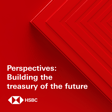Become a Creator today!Start creating today - Share your story with the world!
Start for free
00:00:00
00:00:01

Automation: The pursuit of efficiency
From the factory floor to the boardroom and across supply chains, logistics and utilities – the world is becoming more automated. HSBC Global Research’s heads of industrials in Asia and Europe - Helen Fang and Sean McLoughlin - discuss the future of automation and its growth potential. This episode was recorded on Wednesday, July 28 2021. Disclaimer. To stay connected and to access free to view reports and videos from HSBC Global Research click here: https://www.gbm.hsbc.com/insights/global-research.
Hosted on Acast. See acast.com/privacy for more information.
Transcript
Introduction to HSBC Global Viewpoint
00:00:00
Speaker
This is HSBC Global Viewpoint, your window into the thinking, trends and issues shaping global banking and markets.
00:00:09
Speaker
Join us as we hear from industry leaders and HSBC experts on the latest insights and opportunities for your business.
00:00:17
Speaker
Thank you for listening.
Focus on Automation with Industry Experts
00:00:22
Speaker
Hello, everyone.
00:00:23
Speaker
Welcome to this HSBC Global Research LinkedIn Live.
00:00:27
Speaker
I'm Piers Butler, Head of Global Research Direct, connecting you to world-class research.
00:00:33
Speaker
This LinkedIn Live series has been focusing on HSBC Global Research's nine global themes.
00:00:39
Speaker
And today we're going to be looking at automation.
00:00:43
Speaker
And I'm very pleased that to answer your questions on this fascinating topic, I'm joined by Helen Fang and Sean McLaughlin.
00:00:51
Speaker
Heads of Industrial Research at HSBC.
00:00:55
Speaker
And Helen, as well, wears responsibility for being our global theme coordinator on automation.
00:01:01
Speaker
So Helen, let's start off with you.
00:01:03
Speaker
Automation is actually a very broad theme.
00:01:05
Speaker
It's very interconnected.
00:01:06
Speaker
It affects the factory floor, the boardroom, consumers, logistics.
00:01:11
Speaker
What pulls it all together?
00:01:13
Speaker
Thank you, Fias.
00:01:14
Speaker
And it's really an honor to be here.
00:01:16
Speaker
Well, good morning, everyone.
00:01:18
Speaker
So what I see automation is actually the same that increase the efficiency level all across different industries.
00:01:27
Speaker
It can be logistics, it can be industrials, it can be anything.
00:01:31
Speaker
It does not necessarily need to be a robot or a machine tool.
00:01:35
Speaker
So when we were looking along say industrial 1.0 to industrial 4.0, we started from the steam machine for industrial 1.0.
00:01:45
Speaker
This is also called automation because it increased the efficiency level of human being.
Benefits and Challenges of Automation
00:01:50
Speaker
And then electricity was invented.
00:01:52
Speaker
We have 2.0.
00:01:54
Speaker
With robot, we have 3.0, that's where we were now.
00:01:58
Speaker
And going forward with internet, every data is going to be uploaded to the cloud, everything interacted together.
00:02:06
Speaker
With the IoT and automation, that's the ultimate goal of the automation.
00:02:11
Speaker
Thanks, Helen.
00:02:12
Speaker
And Sean, it's fair to say that recently automation has started to impact ESG issues.
00:02:20
Speaker
Now, it's a very broad subject, and I'm sure we'll get more detailed questions on it, but perhaps you can give us an initial sense of that.
00:02:27
Speaker
Sure.
00:02:27
Speaker
And again, thanks for the opportunity.
00:02:30
Speaker
Great to be here.
00:02:32
Speaker
I think with automation technologies becoming more anthropomorphic, in other words, possessing human-like characteristics, I think it's become...
00:02:42
Speaker
I think more urgent to look at the drawbacks as well as the benefits.
00:02:48
Speaker
I mean, the clear benefits, as Helen mentioned, you've got higher productivity, increased output.
00:02:55
Speaker
You have actually more safety and product quality, more efficient use of materials, increased competitiveness.
00:03:03
Speaker
There's all sorts of advantages.
00:03:06
Speaker
On the drawbacks, though, we look across the three components of ESG, the environmental, the social and the governance.
00:03:14
Speaker
From an environmental side of view, actually, having a lot of machinery, actually, potentially, is more energy intensive.
00:03:24
Speaker
There are potential pollution risks when powering some of that machinery.
00:03:29
Speaker
There's also high capex on some of these automation investments.
00:03:34
Speaker
I'd argue as well that
00:03:36
Speaker
particularly on the social side is where I think there is still a public perception question mark around some automation.
00:03:44
Speaker
You hear about, for example, US deaths at the hand of an automated surgeon, effectively scaring people.
00:03:55
Speaker
You hear a lot about Tesla autonomous pilot road accidents.
00:03:59
Speaker
These tend to get a lot of, I think, press headlines, but actually, I think there's probably a good safety record.
00:04:07
Speaker
But it tells you that, you know, public perception around automation is, I think, something that needs to be worked with.
00:04:15
Speaker
I think, you know, we see a lot of sci-fi films.
00:04:17
Speaker
that make us generally quite wary about, I think, some of the risks around, you know, I don't think AI today is able to necessarily be intelligent enough to take its own life form and, you know, potentially turn against us.
00:04:31
Speaker
But, you know, since Isaac Asimov, that has been, I think, in the public's mind.
AI Productivity Paradox and Autonomous Vehicles
00:04:38
Speaker
More concretely though, I think there is a question mark around unemployment on the social side.
00:04:43
Speaker
The definition of automation effectively is mechanization of human tasks.
00:04:49
Speaker
At the same time, on the replacement side, there's actually a real upskilling
00:04:54
Speaker
opportunity as well you know that there's greater demand for skilled labor and ultimately we can take things like use of technologies such as artificial intelligence in predicting natural disasters and detecting diseases so actually it's improving overall quality of life lastly if i may say on the governance side
00:05:15
Speaker
You know, it's down to companies investing in automation.
00:05:18
Speaker
We're seeing more and more companies now having technical member of the board that is helping to drive through these very technical decisions around investing in automation.
00:05:29
Speaker
You mentioned AI and Helen, if I could just pick up on that, because in your recent report, you talked about AI and the productivity paradox.
00:05:38
Speaker
Can you tell us a little bit more about that?
00:05:41
Speaker
Well, people talk about the productivity paradox more under the definition of, say, there is more innovation.
00:05:49
Speaker
However, there seems to be less growth.
00:05:53
Speaker
Well, there are two different implications of that one.
00:05:57
Speaker
First, it could be the AI, although it is linked to the software and etc.
00:06:02
Speaker
The application of it is still under different trials, like Sean just mentioned.
00:06:07
Speaker
We're still on a trial base trying to use the AI and the combination with automation at a wider application.
00:06:16
Speaker
The other thing is what people worried about with AI and automation, more jobs are going to be given over or handed over to the robot.
00:06:26
Speaker
Well, this is not necessarily
00:06:30
Speaker
happening because what we have been seeing is it is just freeing people from repetitive and dangerous jobs and more people got skewed up, meaning being trained to either control the machine or control the robot and being freed away from their dangerous working environment previously.
00:06:48
Speaker
And Sean,
00:06:50
Speaker
Automation in fact crosses over into a number of the other HSBC global themes.
00:06:56
Speaker
I'm thinking about the future of transport and autonomous vehicles, future cities, self-driving buses and efficiency around that.
00:07:06
Speaker
I mean, where do you see the strongest kind of crossovers?
Global Automation Trends and Data Control
00:07:10
Speaker
Well, I think certainly on the transport side, I'd mentioned this earlier, the Tesla autonomous pilots, we're seeing
00:07:18
Speaker
autonomous driving as an area that's really taking off, that companies are investing strongly into.
00:07:29
Speaker
And this is based on a huge amount of information.
00:07:33
Speaker
First of all, the amount of sensors that you need to actually be installed in
00:07:37
Speaker
onboard the vehicle, lidar, radar, detecting everything that's moving around it.
00:07:43
Speaker
All that information has to effectively then be channeled and transmitted to a place where it can be processed and in real time give the car the ability to change its direction or interact depending on what's in front of it.
00:08:01
Speaker
Where are we seeing the most density in terms of
00:08:06
Speaker
automation in which countries are leading away relative to others.
00:08:10
Speaker
Perhaps you can give us an insight into that.
00:08:13
Speaker
Sure.
00:08:13
Speaker
For people who are not familiar with this definition, the robot density means how many robots does every 10,000 workers have on the factory floor.
00:08:24
Speaker
And that basically is an indicator for the automation level of different countries.
00:08:30
Speaker
Well, then that comes back to the growth driver for automation, which is the aging population, while also the increasing labor costs and what is the contribution from your GDP growth.
00:08:42
Speaker
So if you are actually looking at US, US is among the top five of the robot density.
00:08:48
Speaker
The reason behind that will be their very good pharmaceutical and also the automobile industry.
00:08:54
Speaker
If you were looking at the aging population and increasing labor costs as a driver,
00:09:00
Speaker
It won't surprise you that you see Japan as among the top three density, the highest density for zero density globally.
00:09:09
Speaker
And similarly, because South Korea has a heavy focus from their GDP towards a semiconductor, they are among top three as well.
00:09:18
Speaker
Interestingly, you see China catching up really fast in terms of automation upgrade.
00:09:23
Speaker
I think behind that will be still the increasing labor costs, the aging population, and also a non-auto, non-smartphone kind of application of robot in China because they were trying to combine the robot with different industries, including the spinning industry and packing industry, food and beverages, which definitely drives the increase of the automation density in China.
Pandemic's Impact on Automation Adoption
00:09:51
Speaker
These robots are collecting an enormous amount of data.
00:09:56
Speaker
What are we doing with this data?
00:09:57
Speaker
Is it useful?
00:09:58
Speaker
Is it too much data?
00:09:59
Speaker
How do we control it?
00:10:00
Speaker
Maybe a few comments on that.
00:10:02
Speaker
Well, I think this raises some questions, firstly around ownership and Border Patrol, effectively.
00:10:11
Speaker
Who owns this data?
00:10:13
Speaker
Where is it kept?
00:10:14
Speaker
Particularly as everything is moving to the cloud, it's clear that there is a very concentrated ownership of those assets in the cloud.
00:10:24
Speaker
And I think more and more...
00:10:26
Speaker
companies now are concerned about particularly sensitive data effectively being located in the cloud where it's not necessarily clear who can see that and how secure that might be.
00:10:43
Speaker
So certainly in Europe there's a project called Gaia X
00:10:48
Speaker
that's trying to establish a framework for around ownership of data to really try to let's say how can I say levelize equalize the ownership debate and make this problem and effectively resolve this problem.
00:11:10
Speaker
Helen one of the things you've written a lot about is machine vision.
00:11:15
Speaker
Firstly just
00:11:17
Speaker
maybe give us a little bit more of an understanding what machine vision is and some of the progresses that have been associated with that and the impact on manufacturing process and efficiency.
00:11:31
Speaker
Yeah, sure.
00:11:32
Speaker
So machine vision is a big definition.
00:11:35
Speaker
It's very broad.
00:11:36
Speaker
Basically, you can understand it as the eye of a robot or the eye of any kind of the machines.
00:11:44
Speaker
Well, it can be AOI, application
00:11:47
Speaker
It can be X-ray, it can be infrared.
00:11:51
Speaker
Anything that enables the machine with eyesight is called machine vision.
00:11:56
Speaker
The application will be inspection, which is usually used in quality control, guiding,
00:12:03
Speaker
gauging and basically enable the machine to see what's around it and cooperate with another machine or human.
00:12:10
Speaker
It is a very vast market.
00:12:14
Speaker
We were estimating for the market to grow to 19.2 billion US dollars by the year 2025.
00:12:22
Speaker
That implies about 8% of the five-year CAGA for the Asia market and about 6% of the CAGA globally.
00:12:30
Speaker
One question that's come up in some of the other LinkedIn lives is obviously the impact of the pandemic, COVID-19.
00:12:38
Speaker
How has that impacted automation in terms of has it accelerated certain developments?
00:12:46
Speaker
Has the benefits of automation perhaps been seen in an even better light in the context
Drones in Automation: Opportunities and Applications
00:12:52
Speaker
of the pandemic?
00:12:52
Speaker
Sean, do you want to take that one?
00:12:55
Speaker
Yes, I'd certainly, I would say that COVID has helped to accelerate automation.
00:13:00
Speaker
The fact that we're all, you know, virtually linked today via digital networks is certainly validation that a lot of the infrastructure works.
00:13:13
Speaker
I think certainly we've seen meaningful uptick in investment.
00:13:16
Speaker
I was listening to a company presentation this morning among their industrial division, one of the end markets that they see has strongest demand, automation.
00:13:27
Speaker
So I think we're seeing very strong
00:13:30
Speaker
data in the market to suggest that we are seeing meaningful investments in automation in a number of industries.
00:13:40
Speaker
So very much, yes, I would say COVID has been an accelerator.
00:13:47
Speaker
We have a question on drones.
00:13:50
Speaker
I mean, obviously, everybody has this kind of vision of some of their online orders being delivered by drones.
00:13:58
Speaker
Drones have become much more of a feature of our lives, sometimes a bit of a nuisance, but where do we see drones in the context of automation?
00:14:07
Speaker
Helen, do you want to start with that one?
00:14:09
Speaker
Yeah, sure.
00:14:11
Speaker
So in terms of the future, I would say there will be twofold.
00:14:16
Speaker
First, if you were looking for an investment, let's see what's inside of the drone, you will have the control system, you will have the battery, which is the
00:14:25
Speaker
basically likes a motor.
00:14:26
Speaker
And also you will have the camera, which is the sensor.
00:14:30
Speaker
Well, I think all along those different value chains, you have some investment opportunities, especially with the battery, because people are still debating on whose drone can fly for longer and take more pictures back home.
00:14:43
Speaker
So there will be a huge competition there.
00:14:45
Speaker
Most of the targets for investment will be in Japan.
00:14:49
Speaker
And for some of the components of the leasing battery, you can be looking at targets in China.
00:14:55
Speaker
The other application of this topic might be where can a joint be used?
00:15:02
Speaker
Military is a very sensitive area, but it is one of the wide applications of this.
00:15:08
Speaker
You have more and more stricter regulations ongoing for the joint.
00:15:14
Speaker
The more commercial one is for taking pictures.
00:15:16
Speaker
We actually had interesting interviews with a lot of CEOs trying to do a startup of drones, you know, just to do some photos for people when they are traveling or doing a family trip.
00:15:29
Speaker
So you do not need to ask a passenger surrounding you and say, excuse me, can you take a picture for us?
00:15:36
Speaker
So instead you can just use your drone to take a picture.
Technical Expertise in AI Strategy
00:15:39
Speaker
That is one of the commercial way of drone in our point of view.
00:15:45
Speaker
Sean, let's come back to this question you mentioned briefly in terms of having technical experts on the board.
00:15:50
Speaker
But are we seeing companies beginning to think hard about their recruitment policies around having the right kind of people to work with an increasing level of AI and automation?
00:16:07
Speaker
I think so.
00:16:08
Speaker
I mean, there's a stat that I can throw at you.
00:16:10
Speaker
I believe it's 44% of UK companies have a technical person on the board.
00:16:16
Speaker
So there's a huge amount still.
00:16:19
Speaker
So the majority still don't, I think, is the conclusion from that.
00:16:24
Speaker
That number certainly has been growing.
00:16:27
Speaker
And it, I think, indicates, you know, we saw this a couple of years ago with digital.
00:16:34
Speaker
So you
00:16:35
Speaker
you saw a lot of CDOs being employed, so chief digital officers that were trying to, industrial companies trying to push through, let's say, a digital makeover of, let's say, traditional, mechanical or non-digital products.
00:16:52
Speaker
The idea that everything is getting connected and you as a manufacturer need to be making products that can talk to each other.
00:17:01
Speaker
I think the next...
00:17:02
Speaker
or the natural evolution of that really is that we see more broadly how companies, particularly manufacturing companies, are reevaluating how they manufacture and what improvements automation can make.
00:17:20
Speaker
So this is going from the very top of the value pyramid, let's say, the so-called ERP, which is Enterprise Resource Planning.
00:17:28
Speaker
So it's effectively a digital overhaul of
00:17:32
Speaker
you know everything that the company does everything is you know you're in contact with your suppliers you can see all your plants around the world in real-time management of supply chain and it's a very powerful tool to drive productivity again you know this this kind of overhaul typically you know requires I think board level buy-in and the technical presence on that board does help to push that through
00:18:01
Speaker
And Helen, we are beginning to see the rollout of 5G mobile networks in different countries.
00:18:09
Speaker
How significant is that in the context of automation and this aspect of automation that perhaps people focus less on because they think about robots on the factory floor but Internet of Things?
00:18:21
Speaker
Yeah, so I think we touched upon that in the previous questions.
00:18:26
Speaker
The industrial 4.0 basically linked to the robot or any kind of automation machinery with the internet under the sphere of the IoT so that all the data can be collected
00:18:39
Speaker
in order to do either predictive maintenance or the data analysis for other users later.
5G's Role in IoT and Automation
00:18:46
Speaker
If we were still using the 4G Internet, we might be facing some technical problems.
00:18:52
Speaker
That will be the latency issue, meaning that when you are processing a huge amount of data,
00:18:58
Speaker
it can drag down the whole speed of the operation.
00:19:01
Speaker
So that's why you would need the 5G infrastructure as a pre-investment for the ongoing IoT rollout going forward.
00:19:11
Speaker
And the IoT combination with the automation will be exciting, not just talking about the driverless car and things like that.
00:19:20
Speaker
It's mostly about massive data being collected and you can massively increase the efficiency level and do the predictive maintenance going forward.
00:19:31
Speaker
So we're sort of nearly running out of time, but one question that has come up is undoubtedly automation can prove to be a significant competitive advantage.
00:19:44
Speaker
Are you seeing or do you expect to see what I would call a kind of leapfrog advantage where particularly in emerging markets you can jump
00:19:55
Speaker
certain stages of industrial development by going straight to the more automated process.
00:20:02
Speaker
Helen, why don't you kick off with that one?
00:20:06
Speaker
Sure.
00:20:07
Speaker
That's what a lot of investors have been asking me about the market share gain, about the technology gap between some DM countries and EM countries in terms of automation.
00:20:17
Speaker
I would say that it did exist for some of the hardware, especially the general hardware, because you have to consider what are the downstream's demand for this kind of hardware.
00:20:30
Speaker
Is it just an automobile or smartphone?
00:20:32
Speaker
Then that would be really difficult for some of the EMs to catch up with the
00:20:37
Speaker
or DM pioneers because most of the demand, the customers, are coming from the DM countries.
00:20:45
Speaker
But if they can find the localized downstream demand for automation, like food and beverage, like packaging, like spinning industry, that will massively speed the adoption rate of the automation upgrade in those DM countries.
Emerging Markets and Automation Leapfrogging
00:21:01
Speaker
And plus, the interesting thing is with hardware, once you can do some general hardware, then you can launch at a large volume.
00:21:11
Speaker
So the OP margin is boosted and you can catch up with the DM countries very quickly.
00:21:17
Speaker
And then you enter into a vicious cycle of ASP cards, so average selling price card, et cetera, et cetera.
00:21:24
Speaker
So you see this market share shift in those EM countries for hardware.
00:21:30
Speaker
But seldom do you see that for software.
00:21:33
Speaker
And I think that in automation, software at least contribute about 50% of the revenue and will only contribute more in the IoT era, so the industrial 4.0 era.
00:21:45
Speaker
So I would be thinking that for the DM industries, for the DM companies in the automation industry, they have to leverage on their software, well, advantage to maintain their growth going forward.
00:21:59
Speaker
Whereas for the EM, well, enterprises of companies in automation, maybe they should start from hardware with a large amount of sold hardware.
00:22:08
Speaker
Then they can leverage on that and then talk about the software application going forward.
Conclusion and Contact Information
00:22:15
Speaker
Well, I think we're nearly out of time, and I think that was a great answer to finish on.
00:22:20
Speaker
Helen and Sean, thank you very much for your contributions today.
00:22:24
Speaker
It's a tough subject to do quickly because it's very broad, but I think we gave people a sense of
00:22:31
Speaker
insights that we have in the sector.
00:22:32
Speaker
If you have any further questions on automation, any of our nine global themes or any other aspects of HSBC Global Research, do email us at askresearch at hsbc.com.
00:22:44
Speaker
So with that, thank you very much for logging in and listening to us and hopefully see you for the next one.
00:22:48
Speaker
Many thanks.
00:22:53
Speaker
Thank you for listening today.
00:22:55
Speaker
This has been HSBC Global Viewpoint Banking and Markets.
00:22:59
Speaker
For more information about anything you heard in this podcast or to learn about HSBC's global services and offerings, please visit gbm.hsbc.com.

















